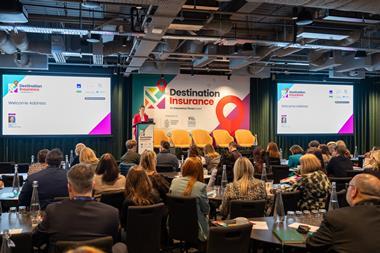When you opened the business section of your paper this morning you probably saw the announcement of yet another merger. Mergers in the past few years have become an everyday occurrence in business life and the insurance industry is not immune. Life companies are demutualising to create larger and more diversified organisations and the number of property and casualty companies is reducing as they are replaced by a handful of global corporations.
What is the driving force behind these corporate marriages? Things can be different in every situation, but the most common reasons are:
- economies of scale – the increase in size of a company reduces the unit costs of operation, which better enables an insurer to compete in a market with declining prices
- access to capital – increases underwriting capacity to cover diverse risks at appealing rates as well as providing for investments in new technology
- competition – the marketplace is changing rapidly; to get to market quickly it is often quicker to acquire rather than grow
- globalisation – global customers require solutions from insurers which can act on a worldwide basis
- intellectual capital – it is becoming increasingly difficult for companies to find and retain qualified people. A merger increases the pool of skilled resources and provides for a greater degree of specialisation.
Whatever the criteria that drive a company into a merger situation, a daunting statistic is that recent studies have concluded that more than 50% of mergers fail to add shareholder value. Given the compelling reasons for mergers, why don't they always succeed?
It has been stated in numerous articles on mergers and acquisitions that most chief executives believe success or failure is driven by integration – the ability of the participating companies to integrate themselves and their staff, processes and cultures. Even with this awareness, the newly-merged entities frequently stumble at the starting gate because of inadequate planning and execution of the integration strategies.
There are four logical phases that are typically associated with a merger or acquisition.
The first is due diligence. This phase is characterised by an operations and financial assessment to establish value, identify strengths and weaknesses and to gain an understanding of the company's products, its workings and the people it employs. It is usually the start of the initial planning process.
Second is solution development, the detailed planning and development of the solutions that form the basis for carrying out the integration.
Third comes integration, the implementation of the plans developed in the previous stage. It brings the organisations together so they can operate as one with a single management and organisation structure.
Last is consolidation, in which the company builds on the success of the merger. This introduces the longest of the stages of integration and generally carries over into business as usual. This is where the company attempts to build on the success of the merger but focuses primarily on solution development and integration.
While there are no simple solutions to the complex issues involved, there are effective strategies and tools that are important if you are to steer your organisation through the turbulence of change in a merger and acquisition. The integration does not just happen, it needs to be well thought out, organised, effective and communicated properly.
The key elements needed for establishing an integration project include four focus areas: planning, systems, communications and human resources. This methodology has been created using the considerable knowledge and experiences that are emerging on how to structure and manage these enterprise-altering experiences.
It concentrates on defining the steps needed for integrating the operations of two organisations, turning the original deal logic into an operational entity through disciplined planning and actionable implementation plans.
We can all appreciate that such an undertaking – merger of any organisation – should not be approached lightly, and we are all well aware of the need for a structured planning approach. Integration planning needs to begin early in the due diligence phase. It has been proved on numerous occasions that when this occurs better decisions are made and result in a speedier, more successful melding of the organisations or, alternatively, the cancellation of the plan because significant differences have come to light that outweigh any potential financial benefits.
Compelling vision and strategy
But what are the important elements? What are the objectives? What are the capabilities of the organisation? Who should be involved and how do you get them involved?
The management needs to establish a compelling vision and strategy, setting core goals and values. You need a strong integration team that is devoted to the job and stays focused on merger-related issues. The merger goals, risk mitigation strategies and governing principles should be clearly articulated. The target for integration should be set and the standard publicised. Creating an integration road map should be the first step towards integration.
The road map seeks to answer the fundamental question: "How will we get there from where we are today?" It should provide a clear understanding and plan of what has to be done to make the merger a success and should ensure that the detailed integration planning is focused on delivering the right results at the right time.
The planning methodology used should help define the steps needed for integrating the operations of the organisations. The process should involve setting up projects that are designed to identify and manage the work of bringing the companies together into a common entity. It should impose strict programme and project management guidelines; this is most effectively done with the project office approach.
A vital piece of integration is the early establishment, usually developed during the due diligence phase, of a comprehensive communication policy that deals with all interested parties. It must be aggressive, constant and consistent, both internally and externally focused. It must reach all audiences with a clear vision and provide clear direction.
Trust must be created
Communication is an essential part of the integration planning. A strategy is created to overcome the gaps that inevitably exist between intentions and perceptions, rumour and reality. It is important that a trust be created between the newly-merged company and those affected by the change. The communication strategy is an excellent vehicle to help develop the trust and the ongoing relationship between all the concerned parties. The plan should address a number of issues that deal with knowing the audience, establishing the procedures, defining the message, methods and timing. The creation of this strategy and the subsequent plans is the first step in an on-going communication programme to keep people informed.
The integration of information systems is one of the more complex activities associated with a merger or acquisition. It also assumes a high degree of risk and the use of information technology as an integral part of an insurance company's operations. The difficulty often arises from having to maintain flawless operations whilst ensuring transition to the desired processing environment.
The work starts in the due diligence phase by establishing "what" needs to be done, followed by the planning phase, which deals with "how" it gets done.
Inventory of IT resources
An initial investigation begins with an inventory of the various IT resources, including hardware platforms, operating systems, applications, processes, people and skills. In parallel, the business conducts an analysis of the products and services of the target company and compares them with its own. A decision is then made that determines the long-term business direction. Once this is known, the IT strategy can be developed and plans formulated. It is essential that the acquiring company has previously established a baseline of its own capabilities, otherwise comparisons cannot be effectively carried out. Most IT integration projects adopt one or more of the following strategies:
- business as usual – the businesses and their IT units remain as separate operating entities. This strategy is most often used where the products and services are complementary and not duplicated
- common user interface – the front-end processes are redesigned, allowing for a common user interface and common skills. Redevelopment can often be time- consuming and complicated. The costs and risks may outweigh the benefits
- quick consolidation – one or another of the company's processing environments is selected on the basis of the best fit for the short to medium-term. The data is then converted as quickly as possible, enabling a fast recovery of operating expenses
- long-term consolidation – this assumes the consolidation takes place as part of a long-term strategy and is carried out on a phased basis. The best applications are selected whether they currently exist or represent a migration to a "new" environment
- consolidate operations – the data centre operations are physically combined in a common facility, thereby reducing the costs. This is not usually a long-term strategy since the organisation does not benefit from a common processing system or a combined database of information.
A successful integration of information services is crucial to the success of a merger or acquisition.
Change management is an essential component of any merger or acquisition. Any significant strategic, structural, technical or cultural change is virtually guaranteed to cause disruption, anxiety and uncertainty. It is human nature that makes people associate change with threats to the status quo. Even change which is viewed positively is likely to affect performance.
With a merger or acquisition you add to the pot the cultural differences that only increase the likelihood of conflict and misunderstanding. A failure to address the people and cultural issues effectively will allow them to become deterrents to achieving a fast and effective integration.
There will be a lack of collaboration between the various groups, important messages will get miscommunicated and there will be a reduction in focus on the task in hand with potential increased disruption to the organisation.
Careful planning of the process encourages the speedy establishment of a supportive organisational structure and a clearly defined human resources (HR) strategy. The HR function plays a major role in the success of the integration by ensuring that the human aspect is not forgotten. Providing change management workshops and education before the integration activities start make staff and managers aware of what is happening, giving them the tools to deal with the significant change that will occur. Demonstrating the commitment of the leadership, establishing the future vision and removing the barriers to change all form part of the HR strategy, which should be designed to minimise the resistance to change and minimise the performance decline during the transition.
The complexity of integration lies in making a number of critical, one-time decisions: brand strategies, selection of technologies, product, service, delivery mechanism, administrative functions, organisational structures and so on. To make things even more complex, integration can be hampered by indistinct cultural and people issues. The circumstances, business goals and operations of the merging entities may also differ significantly. While most successful integration projects seem to share some common characteristics, all of these variables make a "cookie-cutter" solution impractical. The adoption of a logical and planned approach with a focus on common goals, together with a commitment from employees, will improve the success of the integration.
Hosted by comedian and actor Tom Allen, 34 Gold, 23 Silver and 22 Bronze awards were handed out across an amazing 34 categories recognising brilliance and innovation right across the breadth of UK general insurance.












































